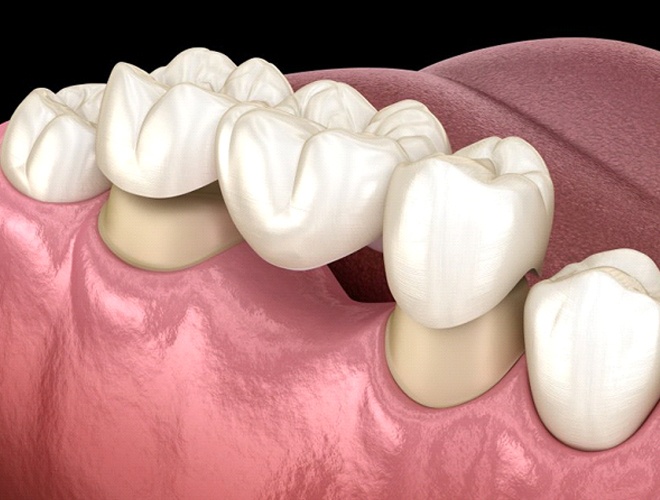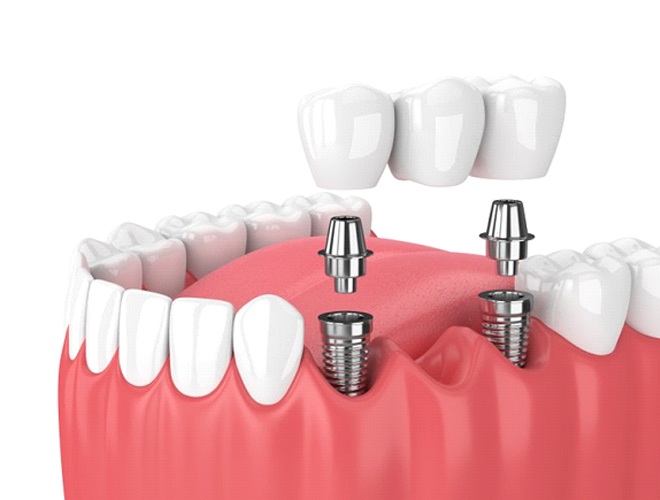

Tooth loss is far from just an aesthetic issue; it can make simple, day-to-day tasks like eating, speaking, and smiling difficult or even impossible. Additionally, not replacing missing teeth leads to problems for not just your oral health, but also your overall well-being. That’s why, at Legacy Dentistry, Dr. Tony Nguyen offers multiple forms of tooth replacement, the simplest of which is a dental bridge. By replacing one or more missing teeth in a row, a dental bridge in Midlothian, TX can literally bridge the gap and complete your smile. To learn more about dental bridges, continue reading below. Then, once you’re ready to explore their benefits for yourself, give our friendly team a call!


A dental bridge is a set of prosthetic teeth designed to bring back one, two, three, and sometimes four consecutive missing teeth. This restoration is fixed in place, only capable of being removed by a dentist. It consists of two dental crowns – each of which is fitted over the remaining teeth at either end of the gap – and as many artificial teeth in between them as it takes to fill the empty space. Once your dentist in Midlothian has secured your bridge into place, you can expect it to give you a fully functional, confident smile for many years to come.

The process of getting a dental bridge begins with a consultation. Dr. Nguyen examines your mouth and reviews your oral and overall health to determine whether a bridge is the right solution for you. If you decide to move forward, he can recommend one of the two types of dental bridges.
In most cases, a dental bridge is supported by two of your natural teeth. A thin layer of enamel will need to be removed from these teeth (known as abutment teeth) in order to create enough room for the prosthetic. Then, the replacement tooth or teeth in the middle sit on top of your gums to literally bridge the gap.
For added security and longevity, a bridge can also be anchored onto one or two dental implants, which are small posts meant to recreate the roots of the teeth. Once we surgically place them in your jaw, they integrate with the bone and form a foundation that can last for decades to come. Then, we attach a custom bridge to the tops of these implants. Not only do implant bridges last longer, but they also don’t require any of your remaining tooth structure to be altered in any way.

Your teeth rely on each other to stay in place. When one or more of them go missing, the surrounding teeth begin to drift out of alignment, which can result in difficulty chewing, a higher risk of gum disease, and a host of other oral health concerns. Luckily, a dental bridge exerts the same pressure on adjacent teeth as natural ones would, keeping your smile aligned.
In addition, having all of your teeth makes it easier to chew crunchy foods like nutritious fruits and vegetables. Therefore, you won’t need to stick to a soft food diet and suffer from nutritional deficiencies that are common in people with untreated tooth loss.
Lastly, dental bridges allow you to smile with complete confidence. We craft our bridges from lifelike materials like porcelain, which can be customized to mimic the size, shape, and color of your natural pearly whites. No one outside of our team even has to know!
No, you cannot take your dental bridge out. Dental bridges are designed to remain in your mouth for many years after being placed. You should not be able to remove your bridge on your own. Only your dentist can do this.
Some healthcare providers may call partial dentures “removable bridges,” however, this is not entirely accurate. Partial dentures are similar to bridges, but one of their key differences is that partial dentures can be removed by the patient at any time, while a dental bridge cannot.
Dental bridges can be made of the same materials as dental crowns. Bridges made from gold or metal alloys used to be the standard, however today most dentists are moving towards metal-free materials such as ceramic and porcelain, as they appear more natural.
At Legacy Dentistry, we proudly use tooth-colored materials in our dental bridges, as we find that these are extremely natural looking while being very durable and long-lasting.
Before preparing your teeth to support your new dental bridge, your dentist will numb the teeth they’ll be working on. Usually, all these needs are a topical anesthetic, but severely nervous or anxious patients may benefit from sedation. Speak to your dentist if you are interested in trying sedation for your dental bridge procedure.
After the preparation and placement of your dental bridge, your underlying teeth may feel sensitive for a few days. Taking an over-the-counter pain reliever should help, but please call your dentist if your discomfort worsens.
Because bridges keep your remaining teeth from drifting out of place, they could potentially prevent discomfort caused by dental drift later on.
If you’ll be getting an implant bridge, you will likely experience some soreness after dental implant surgery, but your dentist will provide you with aftercare instructions to help minimize the pain.
On average, you can expect your dental bridge to last somewhere between five and fifteen years; however, this will vary depending on the materials your bridge is made from.
Dental bridges made of metal often last slightly longer than other materials, but this difference is usually negligible.
More so than the materials used, the longevity of your bridge depends on individual factors like your diet, oral hygiene, and whether you have any bad oral habits like smoking, nail biting, teeth grinding, or eating ice.
Bridges that replace front teeth may possibly last longer than those towards the back of the mouth, as they’re not subjected to as much wear and tear from chewing.
If your bridge is supported by dental implants, it will probably last longer than a traditional bridge. While the restoration itself will need to be replaced eventually, the implant posts will remain in place for many years with proper care.